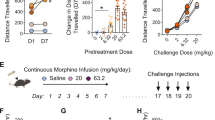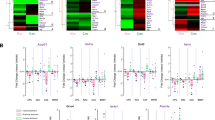Abstract
Dopamine receptors have been implicated in the behavioural response to drugs of abuse. These responses are mediated particularly by the mesolimbic dopaminergic pathway arising in the ventral tegmental area and projecting to the limbic system. The rewarding properties of opiates1 and the somatic expression of morphine abstinence2 have been related to changes in mesolimbic dopaminergic activity that could constitute the neural substrate for opioid addiction3. These adaptive responses to repeated morphine administration have been investigated in mice with a genetic disruption of the dopaminergic D2 receptors4. Although the behavioural expression of morphine withdrawal was unchanged in these mice, a total suppression of morphine rewarding properties was observed in a place-preference test. This effect is specific to the drug, as mice lacking D2 receptors behaved the same as wild-type mice when food is used as reward. We conclude that the D2 receptor plays a crucial role in the motivational component of drug addiction.
This is a preview of subscription content, access via your institution
Access options
Subscribe to this journal
Receive 51 print issues and online access
$199.00 per year
only $3.90 per issue
Buy this article
- Purchase on Springer Link
- Instant access to full article PDF
Prices may be subject to local taxes which are calculated during checkout




Similar content being viewed by others
References
Wise, R. A. & Bozarth, M. A. Apsychomotor stimulant theory of addiction. Psychol. Rev. 97, 469–492 (1987).
Harris, G. C. & Aston-Jones, G. Involvement of D2 dopamine receptors in the nucleus accumbens in the opiate withdrawal syndrome. Nature 371, 155–157 (1994).
Koob, G. F. Drugs of abuse: anatomy, pharmacology and function of reward pathways. Trends Pharmacol. Sci. 13, 177–184 (1992).
Baik, J. H.et al. Parkinsonian-like locomotor impairment in mice lacking dopamine D2 receptors. Nature 377, 424–428 (1995).
Di Chiara, G. & Imperato, A. Drugs abused by humans preferentially increase synaptic dopamine concentrations in the mesolimbic system of freely moving rats. Proc. Natl Acad. Sci. USA 85, 5274–5278 (1988).
Wise, R. A. Neurobiology of addiction. Curr. Opin. Neurobiol. 6, 243–251 (1996).
Bozarth, M. A. & Wise, R. A. Intracranial self-adminsitration of morphine into the ventral tegmental area in rats. Life Sci. 28, 551–555 (1981).
Broekkamp, C. L., Phillips, A. S. & Cools, A. R. Facilitation of self-stimulation behavior following intracerebral microinjections of opioids into the ventral tegmental area. Pharmacol. Biochem. Behav. 11, 289–295 (1979).
Phillips, A. C. & Le Piane, E. G. Reinforcing effects of morphine microinjection into the ventral tegmental area. Pharmacol. Biochem. Behav. 12, 965–968 (1980).
Joyce, E. M. & Iversen, S. D. The effect of morphine applied locally to mesencephalic dopamine cell bodies on spontaneous motor activity in the rat. Neurosci. Lett. 14, 207–212 (1979).
Kalivas, P. W. & Richardson-Carlson, R. Endogenous enkephalin modulation of dopamine neurons in ventral tegmental area. Am. J. Physiol. 251, R243–R249 (1986).
Ettenberg, A., Pettit, H. O., Bloom, F. E. & Koob, G. F. Heroin and cocaine intravenous self-administration in rats: mediation by separate neural systems. Psychopharmacology 78, 204–209 (1982).
Pettit, H. O., Ettenberg, A., Bloom, F. E. & Koob, G. F. Destruction of dopamine in the nucleus accumbens selectively attenuates cocaine but not heroin self-administration in rats. Psychopharmacology 84, 167–173 (1984).
Borg, P. J. & Taylor, D. A. Voluntary oral morphine self-administration in rats: effect of haloperidol or ondansetron. Pharmacol. Biochem. Behav. 47, 633–646 (1994).
Maldonado, R., Stinus, L., Gold, L. & Koob, G. F. Role of different brain structures in the expression of the physical morphine withdrawal syndrome. J. Pharmacol. Exp. Ther. 261, 669–677 (1992).
Bozarth, M. A. Physical dependence produced by central morphine infusions: an anatomical mapping study. Neurosci. Biobehav. Rev. 18, 373–383 (1994).
Longoni, R., Spina, L. & Di Chiara Dopaminergic D-1 receptors: essential role in morphine-induced hypermotility. Psychopharmacology 93, 401–402 (1987).
Fournié-Zaluski, M. C.et al. “Mixed inhibitor-prodrug” as a new approach toward systemically active inhibitors of enkephalin-degrading enzymes. J. Med. Chem. 35, 2473–2481 (1992).
Kalivas, P. W., Widerlow, E., Stanley, D., Breese, G. & Prange, A. J. Enkephalin action on the mesolimbic system: a dopamine-dependent and a dopamine-independent increase in locomotor activity. J. Pharmacol. Exp. Ther. 227, 229–237 (1983).
Daugé, V., Rossignol, P. & Roques, B. P. Blockade of dopamine receptors reverses the behavioral effects of edogenous enkephalins in the nucleus caudatus but not in the nucleus accumbens: differential involvement of delta and mu opioid receptors. Psychopharmacology 99, 168–175 (1989).
Valverde, O., Fournié-Zaluski, M. C., Roques, B. P. & Maldonado, R. The CCKBantagonist PD-134,308 facilitates rewarding effects of endogenous enkephalins but does not induce place preference in rats. Psychopharmacology 123, 119–126 (1995).
Salamone, J. D. The involvement of nucleus accumbens dopamine in appetitive and aversive motivation. Behav. Brain. Res. 61, 117–133 (1994).
Salamone, J. D. The behavioral neurochemistry of motivation: methodological and conceptual issues in studies of the dynamic activity of nucleus accumbens dopamine. J. Neurosci. Methods 64, 137–149 (1996).
Matthes, H. W. D.et al. Loss of morphine-induced analgesia, reward effect and withdrawal symptoms in mice lacking the µ-opioid-receptor gene. Nature 383, 819–823 (1996).
Maldonado, R., Negus, S. & Koob, G. F. Precipitation of morphine withdrawal syndrome in rats by administraiton of mu-, delta- and kappa-selective opioid antagonists. Neuropharmacology 31, 1231–1241 (1992).
Spyraki, C., Fibiger, H. C. & Phillips, A. G. Attenuation of heroin reward in rats by disruption of the mesolimbic dopamine system. Psychopharmacology 79, 278–283 (1983).
Mackey, W. B. & van der Kooy, D. Neuroleptics block the positive reinforcing effects of amphetamine but not of morphine as measured by place conditioning. Pharmacol. Biochem. Behav. 22, 101–105 (1985).
Stinus, L.et al. Chronic flupentixol treatment potentiates the reinforcing properties of systemic heroin administration. Biol. Psychiat. 26, 363–371 (1989).
Smith, J. E., Guerin, G. F., Co, C., Barr, T. S. & Lane, J. D. Effects of 6-OHDA lesions of the central medial nucleus accumbens on rat intravenous morphine self-administration. Pharmacol. Biochem. Behav. 23, 843–849 (1985).
Elmer, G. I., Pieper, J. O., Goldberg, S. R. & George F. R. Opioid operant self-administration, analgesi, stimulation and respiratory depression in µ-deficient mice. Psychopharmacology 117, analgesi23–31 (1995).
Acknowledgements
We acknowledge B. Kieffer for the gift of µ-opioid cDNA. A.S. and O.V. were recipient of fellowships from the European Community and T.A.S. from the Centre Nationale de la Recherche Scientifique (CNRS). This work was supported by funds from the Ministère de la Recherche to R.M., from the Association pour la Recherche sur le Cancer to R.M. and to E.B., and from the Institut Nationale de la Santé et de la Recherche Médicale, CNRS et Centre Hospitalier Universitaire Regional to E.B.
Author information
Authors and Affiliations
Corresponding author
Rights and permissions
About this article
Cite this article
Maldonado, R., Saiardi, A., Valverde, O. et al. Absence of opiate rewarding effects in mice lacking dopamine D2 receptors. Nature 388, 586–589 (1997). https://doi.org/10.1038/41567
Received:
Accepted:
Issue Date:
DOI: https://doi.org/10.1038/41567
This article is cited by
-
Dopamine Receptor Expression and the Pathogenesis of Attention-Deficit Hyperactivity Disorder: a Scoping Review of the Literature
Current Developmental Disorders Reports (2022)
-
Alcohol inhibits morphine/cocaine reward memory acquisition and reconsolidation in rats
Psychopharmacology (2020)
-
Dopamine and addiction: what have we learned from 40 years of research
Journal of Neural Transmission (2019)
-
Effect of Yulangsan Polysaccharide on the Reinstatement of Morphine-Induced Conditioned Place Preference in Sprague–Dawley Rats
Neurochemical Research (2018)
-
Long-lasting effects of adolescent oxycodone exposure on reward-related behavior and gene expression in mice
Psychopharmacology (2016)
Comments
By submitting a comment you agree to abide by our Terms and Community Guidelines. If you find something abusive or that does not comply with our terms or guidelines please flag it as inappropriate.



